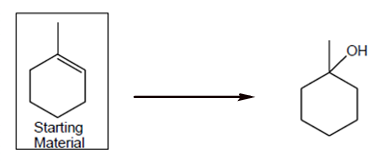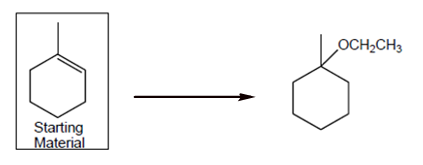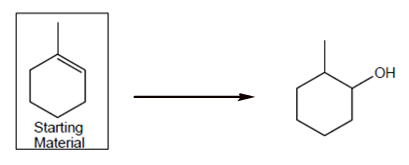
Concept explainers
Interpretation: The synthesis process of given molecule from methylcyclohexane needs to be explained.

Concept Introduction: A
In a chemical reaction; the substance which is involved in conversion is said to be reactant whereas the newly formed substance is called as a product. Both reactant and products must be separated by an arrow.
Halogenation reaction is an addition reaction in which the halogen atoms like Cl, Br are bonded on un-statured carbon atoms of
Interpretation: The synthesis process of given molecule from methylcyclohexane needs to be explained.

Concept Introduction: A chemical reaction is the symbolic representation of the conversion of substances to new substances.
In a chemical reaction; the substance which is involved in conversion is said to be reactant whereas the newly formed substance is called as a product. Both reactant and products must be separated by an arrow.
Halogenation reaction is an addition reaction in which the halogen atoms like Cl, Br are bonded on un-statured carbon atoms of alkene to form alkyl halide.
Interpretation: The synthesis process of given molecule from methylcyclohexane needs to be explained.

Concept Introduction: A chemical reaction is the symbolic representation of the conversion of substances to new substances.
In a chemical reaction; the substance which is involved in conversion is said to be reactant whereas the newly formed substance is called as a product. Both reactant and products must be separated by an arrow.
Halogenation reaction is an addition reaction in which the halogen atoms like Cl, Br are bonded on un-statured carbon atoms of alkene to form alkyl halide.
Interpretation: The synthesis process of given molecule from methylcyclohexane needs to be explained.

Concept Introduction: A chemical reaction is the symbolic representation of the conversion of substances to new substances.
In a chemical reaction; the substance which is involved in conversion is said to be reactant whereas the newly formed substance is called as a product. Both reactant and products must be separated by an arrow.
Halogenation reaction is an addition reaction in which the halogen atoms like Cl, Br are bonded on un-statured carbon atoms of alkene to form alkyl halide.
Interpretation: The synthesis process of given molecule from methylcyclohexane needs to be explained.

Concept Introduction: A chemical reaction is the symbolic representation of the conversion of substances to new substances.
In a chemical reaction; the substance which is involved in conversion is said to be reactant whereas the newly formed substance is called as a product. Both reactant and products must be separated by an arrow.
Halogenation reaction is an addition reaction in which the halogen atoms like Cl, Br are bonded on un-statured carbon atoms of alkene to form alkyl halide.
Want to see the full answer?
Check out a sample textbook solution
Chapter 8 Solutions
Organic Chemistry: A Guided Inquiry
- Provide the major product of the following reaction:arrow_forwardStarting with benzene and using any other necessary reagents of your choice, create a synthesis (or sytheses) for each of the following compounds.arrow_forwardProvide the structure of the major product which results from the following reaction.arrow_forward
 ChemistryChemistryISBN:9781305957404Author:Steven S. Zumdahl, Susan A. Zumdahl, Donald J. DeCostePublisher:Cengage Learning
ChemistryChemistryISBN:9781305957404Author:Steven S. Zumdahl, Susan A. Zumdahl, Donald J. DeCostePublisher:Cengage Learning ChemistryChemistryISBN:9781259911156Author:Raymond Chang Dr., Jason Overby ProfessorPublisher:McGraw-Hill Education
ChemistryChemistryISBN:9781259911156Author:Raymond Chang Dr., Jason Overby ProfessorPublisher:McGraw-Hill Education Principles of Instrumental AnalysisChemistryISBN:9781305577213Author:Douglas A. Skoog, F. James Holler, Stanley R. CrouchPublisher:Cengage Learning
Principles of Instrumental AnalysisChemistryISBN:9781305577213Author:Douglas A. Skoog, F. James Holler, Stanley R. CrouchPublisher:Cengage Learning Organic ChemistryChemistryISBN:9780078021558Author:Janice Gorzynski Smith Dr.Publisher:McGraw-Hill Education
Organic ChemistryChemistryISBN:9780078021558Author:Janice Gorzynski Smith Dr.Publisher:McGraw-Hill Education Chemistry: Principles and ReactionsChemistryISBN:9781305079373Author:William L. Masterton, Cecile N. HurleyPublisher:Cengage Learning
Chemistry: Principles and ReactionsChemistryISBN:9781305079373Author:William L. Masterton, Cecile N. HurleyPublisher:Cengage Learning Elementary Principles of Chemical Processes, Bind...ChemistryISBN:9781118431221Author:Richard M. Felder, Ronald W. Rousseau, Lisa G. BullardPublisher:WILEY
Elementary Principles of Chemical Processes, Bind...ChemistryISBN:9781118431221Author:Richard M. Felder, Ronald W. Rousseau, Lisa G. BullardPublisher:WILEY





